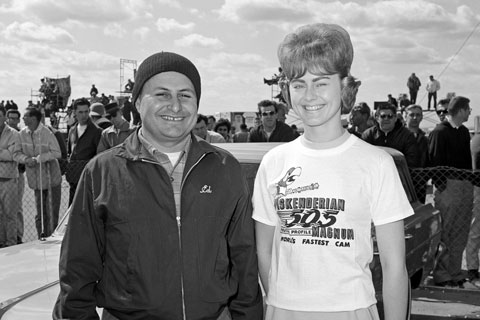SEMA News—August 2011
Golden Dreams
 |
|
The Summers were no strangers to speed, having raced on California’s dry lakes since the ’50s. They set a 279-mph Class C Streamliner record in 1963 with a Hemi-powered ’liner, but they had Campbell’s record in their sights even then. Going after it meant bringing their game to a whole new level, however, and that would require a whole new car.
In this photo, taken in November 1963, Bill (left) and Bob (right) are showing Hot Rod magazine Editor Bob Greene a model of the Goldenrod, the wheeled missile they were building for their record attempt. The brothers understood that aerodynamics would play a huge role in attaining the speed they wanted, so help from a Northrop aerodynamicist and wind-tunnel tests resulted in a car that was 32 ft. long but only 48 in. wide and 42 in. high. Power came from four Hemi engines, on loan from Chrysler, that were mounted inline in the car and run in essentially stock condition except for the addition of fuel injection and the complex drivetrain that sent power to the front and rear wheels.
To call the effort a shoestring operation would be an understatement. The brothers were essentially self-taught hot rodders, and Goldenrod was built in a former vegetable stand in Ontario, California.
The guys got a boost when George Hurst took an interest in the project. He not only donated cash to the effort, but Hurst Performance also helped build Goldenrod’s transmissions and shifter mechanisms. Hurst’s involvement helped bring other sponsors to the car, including Chrysler, Firestone, Mobil Oil and Champion sparkplugs.
The Summers faced hurdles even after Goldenrod was finished: Poor weather kept Bonneville too wet to race on through October of 1965, and the only way they got on the salt once conditions dried in November was to use some time originally booked by Firestone for Art Arfons.
With Bob at the wheel, Goldenrod’s initial attempts were hampered by damaged wheel bearings. But once that issue was sorted out, on November 12, 1965, Bob drove to a 409.277-mph two-way average, setting a mark that would stand for decades.
Goldenrod ran just once more, the day after it set the record, and then Chrysler took its engines back. The brothers left land speed racing and opened Summers Brothers Racing, producing drivetrain and engine products for racers. After years of neglect, Goldenrod was restored and is now on display at the Henry Ford Museum in Dearborn, Michigan. Bob Summers died in 1992; Bill Summers passed away in May of this year.






